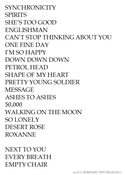
Sting came to play in New Orleans...
In releasing "57th and 9th," all those public relations people and music reporters kept talking to Sting about how this was his first rock album in years.
But to Sting, the former frontman of influential British export The Police, it didn't exactly feel that way.
"I play rock and roll every night, and it's been part of my DNA since I was 7 years old," he laughed in an interview just weeks ago. "That puzzles me a little bit."
And it was precisely that DNA that fueled his Thursday (Feb. 22) night return to the UNO Lakefront Arena in New Orleans. The genre has fueled Sting for decades, and it's as much a part of his music as the storytelling approach he takes to his songwriting, which, like the musician, can be as much playful as sincere.
With a setlist spanning the hits of Sting's time with The Police and highlights of his most recent album, he led a much simpler band arrangement than his last trip to New Orleans in 2010.
Back then, he was touring with the 45-member Royal Philharmonic Orchestra. This time around, however, he brought just the father/son guitar-playing pair of Dominic and Rufus Miller, drummer Josh Freese plus backing vocalist Joe Sumner, who is Sting's own son and a musician in his own right. The group was also joined by openers Los Bandoleros on vocals, returning the favor to Sting and his band, who joined the earlier performers onstage for their own finale.
Wearing a pair of tight black jeans and a tight blue shirt only rockers can really get away with, Sting led the charge for nearly two hours and two encores, slowly warming up an audience clearly suffering from what must have been a little Carnival-induced lethargy.
"We are delighted to be here in New Orleans. It's such a special week for you. We're wearing our beads," said Sting, who had his own green pair wrapped around his left wrist, before introducing his band and the song "She's Too Good For Me" from 1993's "Ten Summoner's Tales."
As bandleader, Sting deftly passed off the spotlight -- literally and figuratively -- to the men around him, finding shadows onstage as the Millers enjoyed solos. But he also delighted in telling his own stories, offering a peek behind the songwriter's curtain as he explained the genesis of "Pretty Young Soldier." (It's inspired by old British folksongs about women crossdressing to find their beloved at war, if you were wondering.)
In introducing his band, Sting joked that he "very shrewdly" hired Dominic Miller's son "as a sort of guarantee, because you never know."
The band also tackled "I'm So Happy I Can't Stop Crying," a song Sting wrote for Toby Keith, but on Thursday, it went reggae.
"We brought the guys to do some very silly back-up vocals, and they have to it because I'm the boss," he said with a smile as the men woo-hoo'd behind him. "See what I mean? Can you do it again? Can you do it all night? I love it!"
The night, however, wasn't all for laughs.
In a second encore, Sting introduced "The Empty Chair," a song he wrote for "Jim: The James Foley Story," a documentary about the war correspondent who was kidnapped in Syria in 2012 and beheaded on camera in 2014. The song earned Sting an Academy Award nomination, and he's next off to perform it at the award ceremony Sunday.
"I watched the film, and I was in floods of tears at the end of it. I was so emotional," he said, adding that his deep response to it initially made him refuse the offer to write a song for it. Eventually, he wondered what he would do if one of his loved ones was abducted, and it mentally landed on the metaphor of leaving an empty chair at the table at dinner time. "At a time when journalism is under attack ... this young man is incredibly important. He put himself in harm's way, he put his life on the line to bring the truth."
In an earlier moment, Sting stepped offstage so Sumner, his son and thusly his own genetic replacement, could channel David Bowie's "Ashes to Ashes" as a poignant introduction to "50,000," Sting's meditation following Prince's death on what musicians leave behind.
The song flowed into The Police's "Walking on the Moon" and "So Lonely," and his own "Desert Rose," which required one of Los Bandoleros smashing on an extra drum kept upright with the musician's foot.
Under a wash of white and then red lights, the whole ensemble fell into "Roxanne," which evolved into a groovy call and response as Sting marched in place and found something sultry for "Ain't No Sunshine" before returning for a funky end to "Roxanne."
And Sting's audience, finally on their feet, clapped for more.
(c) Nola / Times-Picayune by Chelsea Brasted
Sting, Joe Sumner and The Last Bandoleros Let Loose in New Orleans...
When Sting shouted out, “I want to hear you New Orleans!” the crowd shouted back in unison. While the city is in the midst of their Mardi Gras season, Sting brought that same kind of jovial fun to his set on Wednesday night at the UNO Lakefront Arena, performing with bass in hand just about the whole night and doing his trademark jump when the song felt especially good.
What makes this tour happily satisfying is Sting’s return to rocking his music. The last time he played New Orleans in 2010, he was predominately respectful, almost worshipful, of his songs, as they were performed with a symphony behind him giving them grace, emotion and spirituality. For his 57th & 9th Tour, he has dirtied them up a bit and the crowd loved it. Some of the best songs of the evening were rambunctious renditions of “Desert Rose,” “50,000,” “Next To You” and the blending of “Roxanne” with a sultry mid-song departure into “Ain’t No Sunshine” and then back into the raucousness of one of The Police’s biggest hits. And the reggae swinging of “I Can’t Stop Thinking About You,” “I’m So Happy I Can’t Stop Crying” and “So Lonely” has always been one of the best things we’ve loved about the former Gordon Sumner.
With the tour still brand new, having kicked off just a few weeks ago in Vancouver, there is a lot of energy going on. Sting has brought his son, Joe Sumner, along as not only an opening artist but utilizes his pipes as one of his background singers. The Last Bandoleros, a young band out of San Antonio, Texas, whose debut EP was just released last month, follow Sumner with five songs of their own as well as doing backing harmonies throughout Sting’s main 22 song setlist. In fact, the whole show is a group effort. Sting and his band – Dominic Miller, Rufus Miller and Josh Freese – come out for the last song of the Last Bandoleros set, making for a party onstage during “Where Do You Go?” The act is reciprocated during the first encore of Sting’s set when everyone joins him onstage.
Actually, Sting opens his own show with an acoustic “Heading South On The Great North Road,” a song off his new 57th & 9th album, released in November of 2016. He then introduces his son, who performs three songs, then the Lost Bandoleros come on and then it’s Sting, his bass and a whole lot of good music. He performs eight songs from the new album and eight Police songs, with only seven songs repeated from the 2010 performance.
Sumner, who is transitioning from the angry young rocker who spit out songs with his longtime group Fiction Plane into a singer-songwriter with more folk leanings than punk. Having begun his musical journey after discovering Nirvana and writing such songs as “Get Out Of My Face,” “Zero” and “Drink,” which he performed on an acoustic guitar during his mini-set, his new inspirations are coming from areas of deep thinking and family life. His new song, “Jelly Bean,” is a loving ode to his children. During his father’s set he comes back to the front of the stage to sing the David Bowie song “Ashes To Ashes,” a definite crowd pleaser if New Orleans was any indication.
The Last Bandoleros, although together for about three years, are just getting their careers started, and having a prime slot on the Sting tour should open more doors for them. A mix of rock and so-called Tex Mex, their set consisted of “Maria,” “River Man,” “Take Me To It,” “I Don’t Want To Know” and the fun rocker “Where Do You Go?” Singer Jerry Fuentes described “I Don’t Want To Know” as having been inspired by his mother’s living room decorations and it features a bouncy rhythm with Fuentes singing the first verse, guitarist Derek James on the second and bassist Diego Navaira on the last. Drummer Emilio Navaira returns to the main stage during “Desert Rose” and is one of the main reasons the song rocks as hard as it does.
One of the highlights of seeing Sting is his backing band. The often overlooked but extremely talented Dominic Miller lets loose and the smile on his face translates to his playing, hypnotically shining on “50,000” and playing a quite lovely intro to “Shape Of My Heart.” Miller’s son Rufus has come by his chops naturally yet is driving off in somewhat of a different direction. With his long hair and almost headbanging enthusiasm, he takes his soloing into a slight metal edge. If he is ever let loose, he will spray paint the wall with some hellacious notes. And drummer Josh Freese is just simply one of the best.
Not everything Sting gave us was supercharged. He allowed “Shape Of My Heart” to float on that lovely melody and the elder Miller’s gentle guitar playing. And the Academy Award nominated “The Empty Chair,” which Sting wrote about journalist James Foley who was beheaded by Isis in 2014 and is in the documentary Jim: The James Foley Story is heartbreaking in nature and presentation. Sting explained that he was too emotional about the story to write a song when they asked him to do so. But then one day as his own family was gathering around him, he began thinking what he would do if one of his children were in captivity and how would he deal with it, and one of his thoughts would be to have an empty chair at the table for them. Sting performs it at the very end of his show, by himself, playing an acoustic guitar. After such a fantastic evening featuring songs new and classic, leave it to Sting to send us home thinking about more than the music we just heard. A subtle hint that the world is changing and each one of us can play a big part in making it a better place.
(c) Glide Magazine by




